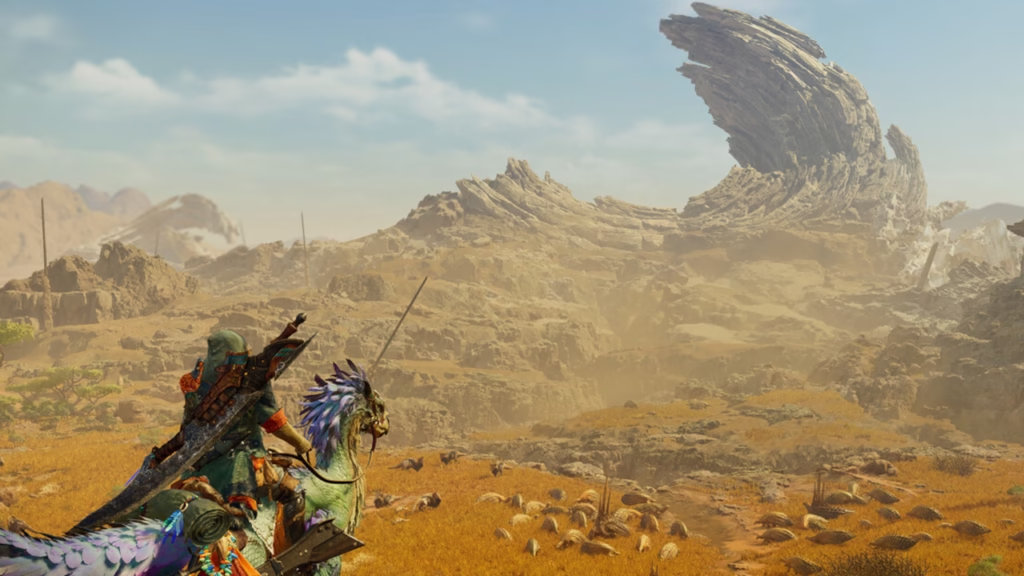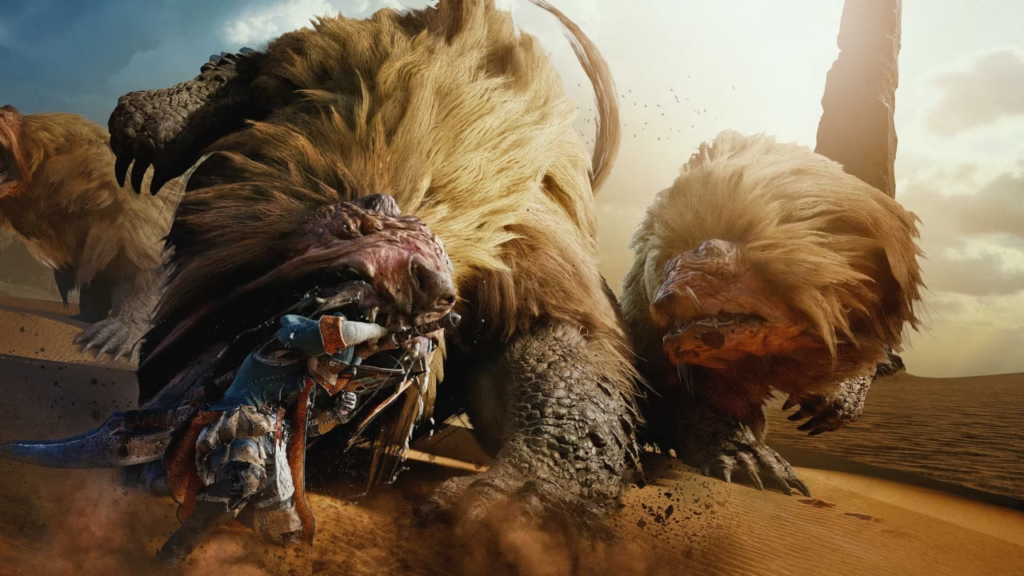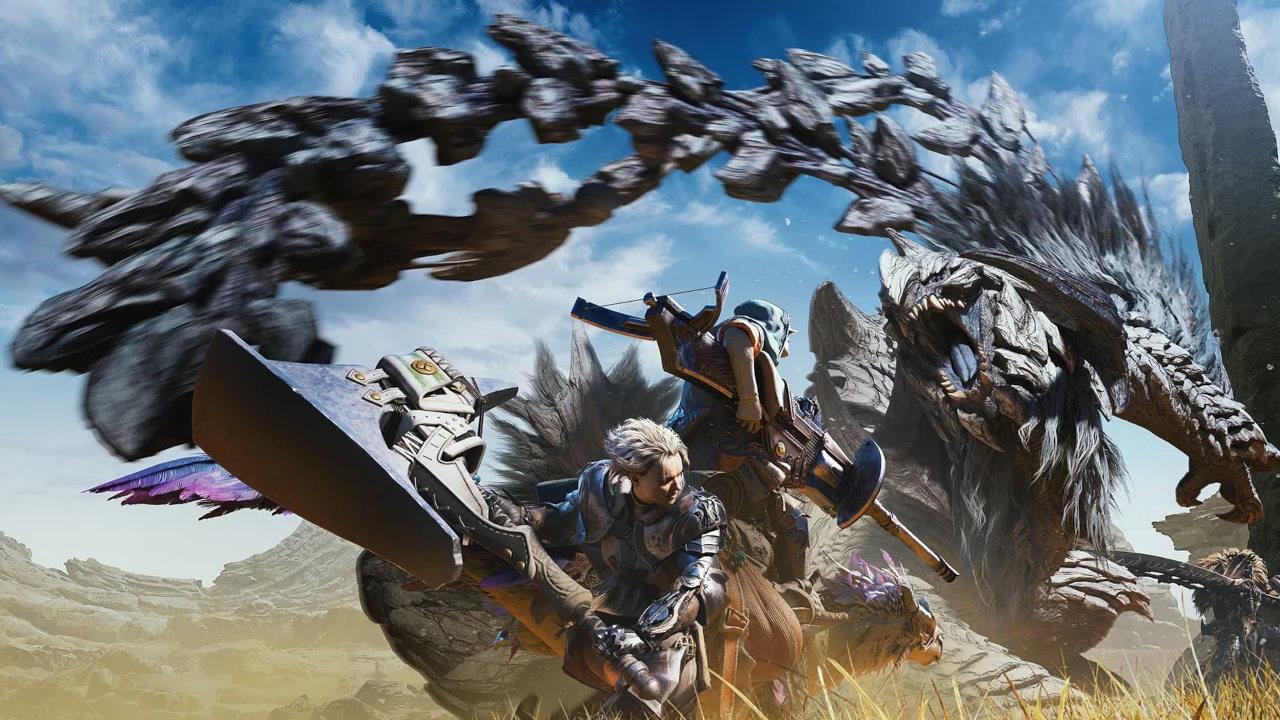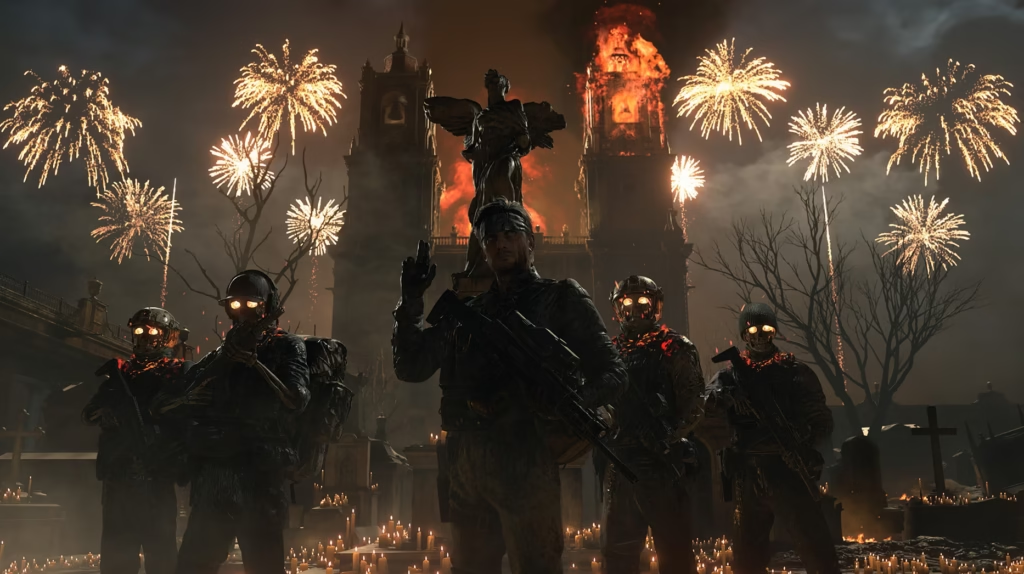As far back as I can remember, I always wanted to play Monster Hunter. Or at least since World released back in 2018, and broke into the broader gaming consciousness. The beautiful environments, the grand creature designs, an exciting-looking gameplay, and all helped on by a very vocal (and growing) fanbase. The game seemed to have a lot going for itself. Now, I can give you perhaps half a dozen reasons why I didn’t or couldn’t until now: not enough time, the reputation of janky mechanics et al. But there’s one above all others that always stopped me in my tracks even as the game was selling for a tiny fraction of the original price in recent years — hunting monsters.
While there is no dearth of titles where you find yourself in the presence of a monster with the objective to kill it; more often than not, your sole identity is not that of a wildlife hunter, and neither is the game’s principal preoccupation catering to that. Let’s be clear, when I say monster, I don’t mean the one which is defined as ‘an imaginary frightening creature, especially one that is large and strange’ in mythologies and the likes (as in, God of War, Assassin’s Creed Odyssey, Black Myth: Wukong, so on and so forth), but more akin to ‘a thing of extraordinary or daunting size’ in an ecosystem, in line with the fantastical, yet grounded world and logic of Monster Hunter. In so many words, the premise of a game built around blood sport never quite sat well with me. (And as I would go on to discover, the game itself is clearly not at ease with the notion, but more on that in a bit.)
Then in rolled Wilds — a spiritual successor to World — with its promises of being the most beginner-friendly and polished title of the franchise. If I was ever going to give Monster Hunter a go, now was the time. And so I convinced my flora and fauna loving self that if I could step into the shoes of happy-go-lucky mass murderer Nathan Drake and even bypass (at least for a bit) the icky feeling of walking around in The Division 2, perhaps I could wrangle in a few innocent monsters as well.
If, like me, you have never played a Monster Hunter game before, starting out with Wilds feels akin to leaning how to ride a motor scooter. More specifically, one of those old Vespas or Bajaj Chetaks, but ones still in pretty good condition. There is a thrill to it, the electric feel of riding a two-wheeler, the elevated sensation of speed and tarmac, the wind in the hair. But there is also the constant fiddling with the clutch and shifting gears, the heightened sense of staying safe while hoping nothing breaks, and not to forget the manual kickstart. When all is working well, every ride is feels effortless and an absolute joy, but at any time things can also come to a grinning halt, suddenly bringing into contract that you’re riding a relic.
The first couple of hours after you boot up are possible the ones that make you feel the most out of sync. It’s a new world where, while not necessary, some knowledge of the lore from previous releases is helpful to plant your feet on the ground. This is also where you first encounter the game’s absolutely atrocious dialogue-writing and hardly better voice acting. But it’s in those initial moments when your HUD pops on, and you get access to the menus, and generally a feel for the UI that you really want to curl up in a ball. Thankfully, all you need to do is take a breather, sit tight for a few missions (which also double as basic tutorials), come to grips with one archaic menu system at a time, and soon enough you’ll begin to feel at home. (And if you don’t quite want to deal with the last one, worry not, the game provides a number of assistance options for managing inventory, and even suggestions for gear.)

Once you do start to get into the rhythm of the core gameplay loop — which broadly involves prepping, hunting and crafting — the quirks start to fade, and the good parts begin to take over. And there is a lot the game excels at.
Let’s start with one of the first choices you make — picking a weapon. There are 14 options to choose from, and most of them feel and play very different from one another. From the beginner-friendly Dual Blades to the more eccentric Hunting Horn (where you perform melodies that give you buffs), there is one to scratch almost every gameplay-style itch. Impressive still is the depth and versatility boasted by each weapon, no matter how innocuous-looking they might come off at first. Step into the (very useful) training area, and you can spend a long time familiarising and perfecting your weapon of choice, be it melee or ranged, heavy or light, or something in between. And while sticking with one weapon for an extended period of time is quite rewarding, there is also no reason to sweat over making the “right” call at the get-go. You can not only switch weapons later on, but a few missions on, you also get to wield a second one which can be switched between during active combat. For me, it was the Insect Glaive, something which I found sat nicely between the conventional options and the more advanced ones. I did also pick up the Bow as my secondary, but practicality never used it. The Glaive, with its fluidity and vertical manoeuvrability, was just too much fun to let go.
Prepping prior to a hunt essentially involves making sure you have everything needed before heading out. This could be the right potions, weapons, armour, and so on. All this is done on various base camps, which, as the name suggests, act as a central hub for everything from the aforementioned training area to a crafting outlet, and a tent to rest and replenish yourself. It’s also where you convene after most missions to take stock, pick up further quests or interact with other characters (and it would be quite remiss of me not to mention here how gorgeous almost everyone looks in this world; that monster-base moisturiser must be something else), including your team of four, which involves a Palico (a feline-like companion that assists you in combat), a Smithy (to forge or upgrade weapons and armour), a Handler (who gives out quests), and, of course, your own self, the Hunter. Which also brings us to the “story” side of the game. At best, it’s serviceable enough to act as a guide to the world and charting a course through the map; at not-so-best, it’s a thoroughly confused narrative (especially towards the end) with a princess-is-in-another-castle-esque quality that’s distracting in a lot of instances, if not outright unnecessary. All made exponentially worse by the inexplicable, fifth-grader dialogues. If you do wish to obtain some interesting and useful information, just check out the in-game Monster Field Guide.
The meat of the matter is the titular monster hunting part. And blessedly, that makes up a thousand times for every little flaw the game has. Here I’ll abstain from the more finer details, for one of the true great joys of the game are your initial encounters with the monsters. The way each one is unveiled, the first time you discover their movesets, abilities and attacks patters. Oh, what drama, what anticipation, what awe… it’s all quite brilliant. And how inspired each design. Take the incredible Lala Barina, a personal favourite (and also part of some previews, so little risk of spoilers here), for example: a giant white-furred spider which can open its thorax — resembling a rose in bloom — to disperse a paralysing agent in the form of florets.

Moreover, Wilds’ attention to details and captivating designs are not limited to the big showcase monsters. The vivid landscape teems with a large variety of lifeforms, boasting an ecosystem that feels similarly rich and alive. And the game does a good job of making sure it all doesn’t just feel cosmetic, with monsters having regular run-ins with each other (even during quests) or interacting in other ways and forms. Add to it a weather system, and the topography is not only shifting with the seasons, you also get to witness some spectacularly cinematic battles — storms raging, lightning strikes and, of course, the soaring music to tie it all together.
And if you were wondering, fighting these stunning monstrosities is equally satisfying. Depending on your weapon of choice, you can strategize and engage in a number of ways, although head-on attack often feels like where it’s at. The styles and combos weaving into one another, the studying of and staying one step ahead of a monster, the choice of gear, managing consumables, sharpening your weapons… this is where everything begins to come together in a dance of hostilities. But there is further depth beyond the hacking, slashing and shooting. You can discover and focus on a monster’s weak spots, or wait for your Palico to distract the beast before launching a blistering attack (or just use the pause to heal yourself). If things get a little too overwhelming, you can always fire an SOS flare, summoning other players or NPC for assistance (the latter, if nothing, do a great job of distracting the monster).
All of which leads into the rather prickly topic of how difficult the game really is? Well, while it’s near-impossible to pass a sweeping judgement in the regard, I would say pretty easy. In fact, a bit too easy at times. Again, this was my first rodeo with a Monster Hunter game, and I didn’t fail a single quest. For every monster encounter, the game allows you to “faint” a couple of times, that is, if your HP goes down to zero, you are dumped back at the camp for a breather, from where you can go back to the monster and resume exactly where you left off. Or in old-school speak, three lives before you fail a quest. I did faint a few times, but it mostly came down to a passive approach to consuming health items or playing on with the same armour for hours, and not a (as kids call it) skill issue. While you can’t button mash yourself to success (and where’s the fun in that anyway?), the bar is not set too high. And this is coming from someone who does have a skill issue when it comes to the likes of souls games. But at times, the scale and bravado is lost when little is being asked of you. On the flip side though, this might not necessarily be a bad thing for those with limited time at their disposal (the game design generally values your time), and in the age of git gud, even a refreshing boon for some.
And speaking of an armour, there are plenty you can craft, along with weapons and other gear. The process is relatively straightforward — you collect materials (including monster parts after a hunt), bring them back to Smithy, browse some clunky menus, and that’s about that. For the most part. While you can tackle the main story with little crafting beyond the basics, as with most things in the game, there’s a reasonable depth to be found here, and you can spend considerable time becoming the best version of yourself, which comes more into play later on.
Which brings us back to the initial (at least, personal) conundrum of trying to justify the central premise of the game after all the prepping, hunting and crafting: Venturing into the wilds and killing creatures. The game tries and tries to give you reasons why each hunt is necessary (which, again: armaments-wielding groups exhibiting colonial-ish tendencies and deciding who lives and who dies in lands they just discovered) — sometimes a monster is threatening a community, or is just about to kill someone — but often dissolves into an almost fourth-wall-breaking ‘you know what the game is about, so just get on with it’. In the process, exaggerating its own discomfort, made all the more strange by the fact that every monster, at some point during the fight, retreats and tries to get away from you. Then to chase after these remarkable lifeforms like a sadistic psychopath in order to put them down, well, it’s something. The game doesn’t forget to pay lip service to the notion of “outsider” in passing, but when you are playing the saviour of natives of the land, who cares, I guess.
Strip those bits away, and if you hold Wilds’ in the light of a fighting-style game, where you and your opponent stand in isolation to face each other, this is a giddily enjoyable title that constantly leaves you in awe. Even as some novelty factor is lost in the latter parts of the game, the thrill and excitement of facing a new opponent never gets old. And if it ever does, chances are all you need is a well-done steak.
Retail copy of the game reviewed on PlayStation 5


